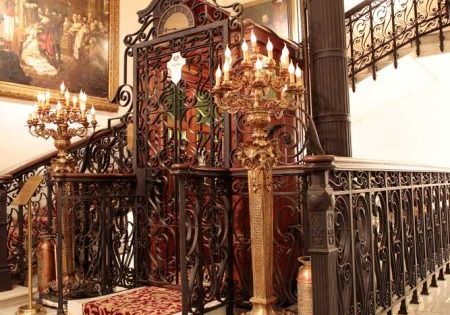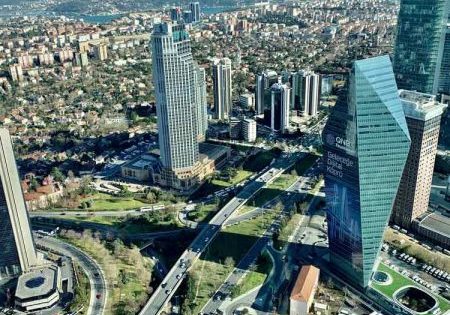I have been asked to write an article about İstanbul. It may seem to be an easy job at first sight, but writing about Istanbul is a hard task. It is hard because most people, like me, do not know many things about the city they inhabit, as they think they will find some books to read or have a chance for sightseeing one day. Years pass by, and people continue to be strangers to the city they live in without being aware of it.
There is the other side of the medallion; you may live in Istanbul but being or not being from Istanbul is another question! Istanbul allowed a lot of immigrants, so much that if research is done to learn the number of people who are really from Istanbul, I think this number will not exceed 10% of 16 million people.
What does being from Istanbul mean?
For me, man is from the city he earns his living, not from the city where he was born. Embracing the city one lives in is better and more meaningful. Otherwise, there would be injustice to the city in which he lives.
Istanbul is a city that must be experienced, not just read about in the many articles published about it. Even so, there are important references talking about Istanbul:
- Murat BELGE – “İstanbul Gezi Rehberi”
- Çelik GÜLERSOY – “Nasıl Bir İstanbul, Beyoğlu’nda Gezerken ve Dolmabahçe”
- Jak DELEON – “Beyoğlu’nda Beyaz Ruslar”
- Celal Esad ARSEVEN – “Eski Galata ve Binaları, Eski İstanbul”
- Selim İLERİ – “İstanbul Yalnızlığı”
- Lucyna ANTONOWICZ – “Polonezköyü (Adampol)”
- Çağla Derya TAĞMAT – “Kültürel Boyutlarıyla İstanbul’da Helenizm”
- Robert MANTRAN – “17. Yüzyılın İkinci Yarısında İstanbul”
- Stefanos YERASIMOS – Ayasofya
- KOÇ Group’s İstanbul encyclopedia
İstanbul
İstanbul is a metropolis situated at the meeting point of Europe and Asia and has a history of nearly 3,000 years. It became the capital city of the Roman, Byzantine and Ottoman empires for 16 centuries, and is one of Europe’s most populated cities today. Sixteen million people live in Istanbul, which is 20% of Turkey’s population. Having one third of the country’s GDP, the metropolis also hosts a huge economy with 50% of the country’s export volume.
As well as being a business and trade center for centuries with its magnificent Bosporus; Grand Bazaar, which is one of the oldest shopping malls of the world; Bankalar Street in Karaköy; Galata Tower; Sirkeci train station; Sultanahmet square; Topkapı Palace and Hagia Sophia, Istanbul is global tourist attraction today.
Istanbul owes its importance to its geographical location. Bosporus carries the Black Sea on the north to Marmara Sea on the south and connects Asia and Europe.
Çanakkale, which is another city in the region, has similar geographical features. So, why not Çanakkale, but Istanbul that always grows and develops? According to Robert Mantran, the biggest difference between these two cities is the Golden Horn. Golden Horn, which is a safe port against all winds in all seasons, which brings a security privilege to İstanbul.
İstanbul, Capital City of the Roman Empire
Roman Emperor Aurelius Constantinus (272-337) is the first one who made Istanbul a world city. As a solution to the problems of the Roman Empire, the emperor divided the Empire into two administratively, making Istanbul the
capital city of Western Rome. So, İstanbul was rebuilt as a capital city calculatedly.
Greek-Latin style developed avenues with columns on both sides. In this model, avenues and streets were straight as much as possible and would cross each other on right angles. Avenues would communicate with wide squares
and create junctions. Symmetry was an important principle in the Roman Empire, as was splendor and monumentality. Social needs of the privileged free citizens had to be met.
Symmetry and straight avenues would create a transparent city structure in line with the public element of Greek-Latin culture.
Istanbul showed a rapid development in line with these principles, and it proved that Aurelius Constantinus had made the right choice.
İstanbul and Byzantine Period It is hard to say when Eastern Rome became “Byzantium”. The Byzantines defined themselves as Romans, but with a difference; while Byzantium was a Christian Empire, the Western Roman Emperor Aurelius Constantine was not a Christian, originally. Autonomous nobility was prevalent in Western Rome. The nobility was not always politically dominant, but it had significant impact on the management. On the other hand, autonomous nobility never occurred in Eastern Rome like in the Ottoman Empire.
Emperor Justinian I, originally Flavius Petrus Sabbatius Iustinianus (482-565), combined Greek-Latin tradition with Christianity brilliantly. The greatest monuments of Christianity, notably Hagia Sophia, were built in Istanbul during this period.
Stone is widely used in constructions in Rome and Byzantium. Stone and brick are costly construction materials. In the Roman Empire, they found a way to use stone and brick efficiently and aesthetically in construction.
İstanbul and the Ottomans
When Mehmet II conquered Istanbul from the Byzantine Empire in 1453, the city was highly damaged. As the Turks came from nomadic life and were used to living in a rural
area, the number of houses that had gardens increased in Istanbul. In the Ottoman Empire, the construction material was wood instead of stone. Unfortunately, there was a problem with it: fire. Indeed, Istanbul experienced many fires for centuries.
Mehmet the Conqueror preserved the multinational fabric of the Empire by settling Turkish, Rum and Armenian communities within the city, and this situation continued over the next periods.
Istanbul and Ottoman Reform Movement
The Industrial Revolution that began in the West in the 19th century rapidly changed the face of the cities in Europe. The Ottoman Empire and its Palace Management in İstanbul, which weakened and became poor, was confused and helpless against the developments in the West.
İstanbul lost its power like the Ottomans and fell behind the developments of European cities. The biggest problem was transportation and lack of roads. A railway was built despite the limited budget. Steamships were imported, and these steamships carried people from the Anatolian side and the Princes’ islands to the Galata Bridge, which was built at the entrance of the Golden Horn. Then, the electric tramway accelerated transportation, as did the Tunnel-Galata Line, which is the third “metro line” of the world, after those in London and New York and still operates today.
Istanbul and Republic Period
As Istanbul had been the capital city of the Ottoman Empire for centuries, it would not be wrong to state that the Republican Government established in Ankara was founded against Istanbul in a sense.
The conflict between the Republican Government established in Ankara and the Palace Management in Istanbul was not only limited to the fact that the last sultan and the government were based in Istanbul, but also because some of the intelligentsia in Istanbul took a stand against the National Struggle in some Istanbul newspapers. As the Republican Government established in Ankara was where the War of Independence was ruled, Ankara became the new capital city after the war was won. As a result, a dramatic stagnation period began for Istanbul.
Non-Muslims, especially the Rums, who thought they were not wanted by the Republican Government established in Ankara, started to leave Istanbul. Then, the capital tax demanded from the non-Muslims (Inonu period – 1042); the Istanbul plunder on September 6-7, 1955, during Menderes government; and Cyprus problems (1955-1958) accelerated emigration. This rapid change in Istanbul brought a change in ownership. Istanbul, evacuated by the Rums and Armenians, got poor rapidly.
Istanbul lost its incredible privileges of being the capital city of the Ottoman Empire for a long time. For all the reasons mentioned, no critical decision was taken regarding Zoning and Urbanization in Istanbul until 1940.
Menderes, who was in power in 1950, decided to address Istanbul again. While the biggest problems of the city were transportation and infrastructure, the cases in European cities were not imitated. For example, metro projects were not included in the urbanization plan of that period. Superficial and eye-catching projects were emphasized. On the European side, Vatan and Millet streets and coast roads were built. The street between Dolmabahçe and Karaköy, along with Bağdat Street on the Asian side, was extended.
During these changes, many historical buildings were pulled down, and on top of that, the contemptuous attitude towards history became wildly devastating and continued, unfortunately.
For me, one of the biggest disasters Istanbul experienced was “squatting in Istanbul,” which started with rural-urban migration and could not be prevented; it was even supported by the politicians for pulling votes. Without any preliminary plans made for those immigrating from rural areas, the settling of so many people in Istanbul and the creating of the kind of urbanized villager lifestyle that became prevalent in the city created many disorders.
In short, Istanbul gradually became a huge mega-urban village because of unplanned urbanization that started with migration.
Istanbul and the Future
Today, healthy development of a city depends on being international instead of being local. For me, it is a development path that can meet the basic needs of the cities both materially and culturally.
The difference between the international city concept and today’s Istanbul is based on the socio-economic quality of life and cultural aspects. Purchasing power of the people in Europe is sufficient, and the cities develop in a way that makes the lives of the people easier. For example, people have easy access to the museums in the city centers. In urban transportation, subways make human life easier, while the use of private vehicles is at minimum levels. Both local people and foreigners have easy access to the cultural events of the week.
What about us?
There are only a few museums in the whole city, and the entrance fees are expensive. People’s economic power is limited, and many people earn less money than needed to survive. Nevertheless, traffic volume increases, and life becomes harder as metro projects are suspended without any justification, only due to political reasons. Istanbul administration is not given the opportunity to get loans from local sources for the metro projects, and they can only initiate metro projects with the loans they can get from abroad.
The conditions of cinemas and theatres are evident; only a certain segment gets government support, while most of them are politically banned and cannot receive any support.
Many artists and groups cannot perform, as they are banned. For example, Ahmer KAYA, a Kurdish man and a leading performer of protest music, had to leave his country because of the prohibitions and died in a European city. A long time ago, I read a post shared by world-famous pianist Fazıl Say; he was talking about the sorrow he felt when he met with the Turkish people abroad at his Paris and Amsterdam concerts.
Istanbul has been badly governed for many years. During the period when the construction sector accelerated, Istanbul became concrete rapidly, with shopping malls and high-rise buildings replacing parks and green areas.
History Repeats!
Now, the management in Istanbul has changed, but the problems have not ended! The decisions about Istanbul are not made by the ones who are in management of the city, but by the President in Ankara, like it was 100 years ago; it is the biggest obstacle that prevents change.
Istanbul is a living and privileged city. It is trying to regain the title, “The city which is awake for 24 hours,” which has been lost for a long time. To liven up the historical squares and places that are forgotten and lost because no money has been invested for long years, the Istanbul Municipality is preparing to organize some project contests.
An authentic, efficient and sophisticated Istanbul is still possible. In short, Istanbul is getting prepared for being Istanbul again.
Get more of Elevator World. Sign up for our free e-newsletter.








